Enhance the probe interface and performance by implementing these unique technologies, made by us.
The probe interface can be expanded with the ability to minimize the alarm area to provide even easier negotiation of large datasets. Performance of the probes have been optimized to allow for even more features.
The VBC gains full OTT Engine data integration enabling displaying OTT specific alarm data in the same manner as all other interfaces. The probe interface can now be expanded with the ability to minimize the alarm area to provide even easier negotiation of large datasets.
MediaWindow™
The MediaWindow™ is a patented technology for complete access to packet behavior and media loss information.
![]()
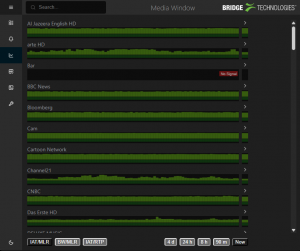 When transporting MPEG data in an IP network, two parameters in particular should be monitored closely: packet loss and packet jitter. If there is no packet loss and packets are transmitted in a reasonably even pace through the network, the signal may be received without transmission errors.
When transporting MPEG data in an IP network, two parameters in particular should be monitored closely: packet loss and packet jitter. If there is no packet loss and packets are transmitted in a reasonably even pace through the network, the signal may be received without transmission errors.
This means that the transmission is completely transparent with respect to signal quality. If however packet loss or excessive packet jitter occurs, the result will most likely be signal impairments noticeable to the end user, for instance in the form of visible picture errors.
A digital television network operator should obviously pay attention to the behaviour of these two parameters, and to facilitate the interpretation of in-duplo series of measurement data, Bridgetech developedthe MediaWindow™ visualisation technique.
The geniusly simple MediaWindow™ displays MPEG over IP traffic performance in a single, composite graph, packet loss and packet jitter being indicated in opposite directions from a base line. Different colours show the network status, and water-flow graphing ensures that both current and historical data are represented. Together these techniques result in a graphical user interface that is packed with essential information, yet intuitive and easy to read.
All IP-enabled Bridgetech probes use the MediaWindow™ technology for unequalled simplicity of confidence monitoring in a complex environment. Deploying Bridgetech probes is an easy way of minimising the time spent solving problems in a digital television network, and a safe way to achieve superior service quality.
MEDIA WINDOW™ ALL RIGHTS RESERVED © BRIDGE Technologies CO AS
Timeline™
As part of the VBC, the Timeline functionality enables operators to go back and explore, understand, verify and document in complete detail what happened at any given time, or look for patterns over longer periods of time to identify and eliminate problems.
![]()

It’s a new graphical data analysis technology that allows users to play through recorded data in an NLE-style Timeline display to observe correlations and patterns of errors occurring over any time period. Users can scrub through the data at any point in the recorded archive, opening and collapsing data tracks, and zooming in to observe fine detail on all the visible tracks. The Timeline shows content thumbnails, alarm markers and all the metrics familiar from the MediaWindow displays, making visual navigation through the data simple and quick. Users can drag and drop data tracks to group them in any order for convenience. Engineers can search through the chain of events that led up to service failures, and generate reports for remedial action or fulfilment of regulatory SLA obligations.
The Archive Server automatically activates the VBC’s Timeline analysis capability for an enormously powerful new way to analyse historical data in depth. ALL RIGHTS RESERVED © BRIDGE Technologies CO AS
Gold TS Protection™
Gold TS Protection is a new technology that makes monitoring for digital services much quicker to set up, and fault-tracking much faster, more accurate and secure. Developed exclusively by Bridge Technologies, Gold TS Protection includes all the checks specified in the ETR290 standard, but goes much further to include testing for critical conditions missed by ETR290.

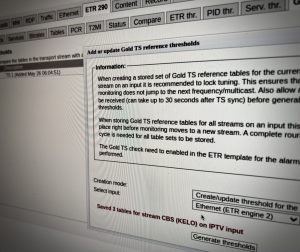
Real-world protection for your services
Conditions like failures of the conditional access system, errors in the program guide, and unintended language changes seriously affect subscribers, but standard monitoring systems based only on ETR290 do not raise any alert for these conditions. Services protected by Gold TS catch these ‘ETR290-legal’ errors and provide a much more valuable real-world quality assurance for operators of digital media services.
Calibrate streams more accurately, in a fraction of the time
Two of the most time-consuming and inefficient areas in media monitoring are the calibration of the monitoring system, and fault-tracking. These two areas of inefficiency can have a cumulative impact, dragging down performance diminishing market acceptance of the provider’s service. Calibration of each stream is normally a long-winded process requiring a lot of operator input and expertise, and very few people in the industry fully understand all the intricacies of ETR290. Operators don’t always have the time or expert knowledge to set the correct values, and consequently the monitoring they can achieve is less accurate and efficient than it should be. Errors go undetected, false alarms add to the ‘chaff’ produced by the monitoring system, and personnel lose trust in the information provided by the system. Now, Gold TS dramatically simplifies the calibration process and makes it easy to set up highly accurate testing within seconds.
See where the fault is, instantly
When faults arise, efficient analysis and diagnosis is crucial for a quick resolution of the problem and the maintenance of good service levels. But in systems available until now, fault-tracking has required technical staff to wade through a large volume of analysis data, searching for the cause of the error. It’s even harder when the criteria set during calibration were imprecise and incomplete. But with Gold TS any and every deviation from the Protection is instantly flagged for attention, and rapid fault-identification is made easy by a clear presentation of the error condition, with the deviation from the Protection values automatically highlighted, side-by-side with the correct values in the Protection. The clarity of the display helps the operator focus instantly on the cause of the error.
Protection above and beyond the industry standard
The automatic fault tracking provided with Gold TS is based not only on the explicit ETR290 checks but also includes otherwise ‘ETR290 legal’ error conditions which the operator must remedy to maintain good service levels. Once you’ve calibrated the stream using the easy Gold TS setup procedure, the stream is continually analysed and compared with the Protection. Gold TS encompasses all the outstanding ETR290 analysis technology developed to date by Bridge Technologies, but it goes above and beyond the ETR290 standard to deliver a much more accurate and comprehensive monitoring safety-net. Error conditions that fall through the cracks of ETR290 are caught by Gold TS.
Simplify the complexity, and do more with less
Gold TS not only makes it far quicker to calibrate streams accurately, but it also reduces the time-to-resolve errors typically by a factor of between 10-15. In operational terms, this means that maintenance staff can effectively monitor larger numbers of streams, because they spend less time setting up the calibration, and less time tracing and resolving errors. And that means subscribers to streams protected by Gold TS get all the time they want watching the highest-quality service.
Want to know more?
If you want to know more about the Gold TS Protection please send an email and we will keep you updated accordingly.
Full Service Monitoring™
FSM™ Full Service Monitoring enables total control The FSM™ framework consists of multiple technologies for detecting service loss or malfunctions of essential services in addition to the broadcast TV stream.
![]()
The FSM™ framework consists of a cluster of technologies for detecting service loss or malfunction of essential services that lie on the outside of the broadcast TV stream. Using FSM™ the probe can monitor the availability of VoD clusters, middleware and other relevant services for customer satisfaction within an IP-based broadcast delivery system. FSM™ works by deploying test agents inside the monitoring probe. Each test agent performs queries across HTTP or ICMP protocols and the user configures rules for the expected return traffic from these queries. Alarms are generated if the queries fail to match the predefined rules. This is similar to testing normally done through an NMS system from a central location. However, the great advantage of deploying test agents from within the probe itself is that the queries can be executed deeper in the network than what is otherwise possible . FSM™ is included as standard in all VB2 and VB3 series of monitoring probes and is an option on the VB1 series of monitoring probes.
FSM™ ALL RIGHTS RESERVED © BRIDGE Technologies CO AS.
External integration interface™
The Eii specification is an interface for 3rd party integration with Bridge Technologies IP-Probes. Its main interface is XML, but full support for SNMP is also provided. The Eii is provided with extensive documentation and is highly scalable for thousands of IP-Probes in one system.
![]()
The Eii™ specification is the interface for 3rd party integration with Bridge Technologies IP-Probes. Its main interface is through an XML-based format served across HTTP/HTTPS. Support for SNMP TRAP alarm messages is also provided. The Eii™ is extensively documented and care is taken to provide backwards compatibility as much as practically possible. The Eii™ interface contains the ability to access all real-time and statistical measurements the probes do and have has comprehensive ETSI TR 101 290 monitoring and analysis support.
Eii ™ ALL RIGHTS RESERVED © BRIDGE Technologies CO AS.
OTT Engines
The active testing OTT Engines are compatible with all IP probes for HLS, MPEG-DASH, Smooth Stream, HDS and RTMP assets
![]()
This enables providers to have real active monitoring of ALL channels provided both for LIVE content and selected VoD streams.
The OTT Engine operates automatically, the input of the content url is the only intervention needed by the operator.
The OTT Engines will then parse the manifest provided by the origin or edge-servers, extract the different profiles served, validate syntaxes, check chunk counters and then do the same for the individual profiles. The OTT Engine can also be used to assess performance of various CDNs and edge-servers, determining which is the most appropriate.
ALL RIGHTS RESERVED © BRIDGE Technologies CO AS
Return Data Path - RDP™
RDP™ to minimize operational cost With the advent of fully duplex technologies as IP transportation, new features for allowing remote access to regional ingressed signal is possible. With RDP™ carriers can centralize both expertise and expensive deep analyzing equipment.
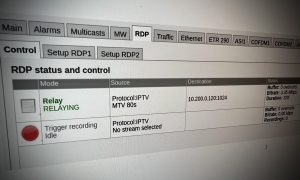
![]()
Return Data Path allows the operator to record video locally on the probe or re-route live video monitored by the probe to a central location for decryption and further analysis. Recording is initiated either directly by the operator or automatically based on pre-defined alarm trigger criteria. In this manner it is possible to have the monitoring probe continuously look for errors and also capture the error event through pre-trigger buffering. RDP is supported on all probes in the VB1, VB2 and VB3 series. All input interfaces supported by the monitoring probe are also available for RDP recording or relaying. This includes the Ethernet interfaces as well as the RF interfaces DVB-C/C2, QAM-B, ISDB-T, DVB-S/S2, DVB-T/T2 and ASI. RDP reduces the need for truck rolls and otherwise necessary on-site visits by skilled and expensive engineers. It does this by making the signals available centrally that are normally only available locally.
RDP™ ALL RIGHTS RESERVED © BRIDGE Technologies CO AS
Microtimeline™
The MicroTimeline™ allows status-at-a-glance for over 200 channels in a single web page with complete service history for the last 96 hours of operation.
![]()
All aggregated events and alarms for the individual services are displayed in the MicroTimeline™ and the severity level is colour coded for easy understanding.

Colour coding can be selected within the VBC server for compability with legacy systems. The MicroTimeline™ also allows for easyer understanding of “correct” errors like daily periods of no transmission and also easier correlation between channels for breakdown into causes for events.
MICROTIMELINE ™ ALL RIGHTS RESERVED © BRIDGE Technologies CO AS
microETR™
The microETR™ technology presents the measurements for many of transport streams in one easy to comprehend GUI.
![]()
The operator can easily click on the stream with errors and drill down to find the cause of the problem. The probe displays full measurements and details for all checks, not just the alarms themselves.
A powerful template system allows alarm settings and thresholds to be reused for ETR, PID, service and RF alarms.
microETR™ ALL RIGHTS RESERVED © BRIDGE Technologies CO AS

MicroBURST Detection™
With the speed of networks increasing and bursty traffic is introduced, small packet forwarding bursts, also called microbursts, can occur.
![]()
This is difficult to understand and monitor since most switches and routers do not give statistics with the necessary detail.
The 10G VB330 can now measure and analyse microbursts and give detailed information on source and duration.
User selectable time between packet can be set and gives for the first time excellent understanding of behaviorism’s in the network that before was invisible. Part of the AEO-OPT (Advanced Ethernet Option) for the VB330.
ALL RIGHTS RESERVED © BRIDGE Technologies CO AS
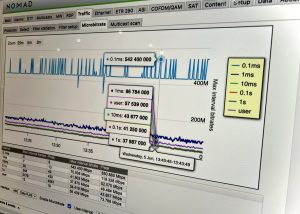
PCAP Recording™
Introducing Ethernet frames/IP Packet recording in the 10G VB330 further enhances the system.
![]()
This first version contain filtering of UDP, TCP or TCP/UDP packet captures and 5 different source/destination filters.
The PCAP file once captured can then be directly downloaded via the web browser to your machine for further processing in WireShark or other software. Part of the AEO-OPT (Advanced Ethernet Option) for the VB330.
ALL RIGHTS RESERVED © BRIDGE Technologies CO AS
microVB™ system - PCAP PFF - filtered forwarding
The microVB™ system have been updated with several powerful features. The ability to monitor and analyse OTT content and powerful PCAP forwarding (PFF - PCAP Filtered Forwarding) can be added to the system as an option.
![]()
In addition to the general v4.10 software release the microVB™ system have been updated with several powerful features.
The ability to monitor and analyse OTT content have been added to the system and powerful PCAP forwarding (PFF – PCAP Filtered Forwarding) can be added to the system as an option.
This allows packets to be forwarded from any microVB™ in the network directly into WireShark for analysis.
ALL RIGHTS RESERVED © BRIDGE Technologies CO AS
Widglets™
Widglets™ API HTML5 video monitor
![]()
The technology is a Widglets™ API HTML5 video monitor for the VB440, that allows the probe to become truly multifunctional beyond its current
widespread deployment for monitoring 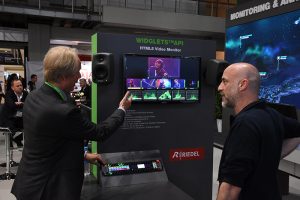 IP networks, extending its usefulness well beyond test and measurement. By leveraging the Widglets API, users can, for example, now deliver a full-motion, colour-accurate and ultra-low latency video monitoring capability to any location or any application where it is needed: all that is required is a laptop and a network connection. Take a camera painter, for instance. Today, the number of cameras that can be analysed is typically restricted to a very few at a time – and with limited views available. More can be analysed – but with the need to acquire and deploy multiple space-consuming boxes. With the Widglets API, a user can have multiple cameras with multiple waveform vectorscopes and streams via a single HTML5 video monitor view; different people in different places can view all this data, instead of splitting it by location or technician. As such: using the new Widglets API for the VB440 patently has incredibly positive implications for remote production.
IP networks, extending its usefulness well beyond test and measurement. By leveraging the Widglets API, users can, for example, now deliver a full-motion, colour-accurate and ultra-low latency video monitoring capability to any location or any application where it is needed: all that is required is a laptop and a network connection. Take a camera painter, for instance. Today, the number of cameras that can be analysed is typically restricted to a very few at a time – and with limited views available. More can be analysed – but with the need to acquire and deploy multiple space-consuming boxes. With the Widglets API, a user can have multiple cameras with multiple waveform vectorscopes and streams via a single HTML5 video monitor view; different people in different places can view all this data, instead of splitting it by location or technician. As such: using the new Widglets API for the VB440 patently has incredibly positive implications for remote production.